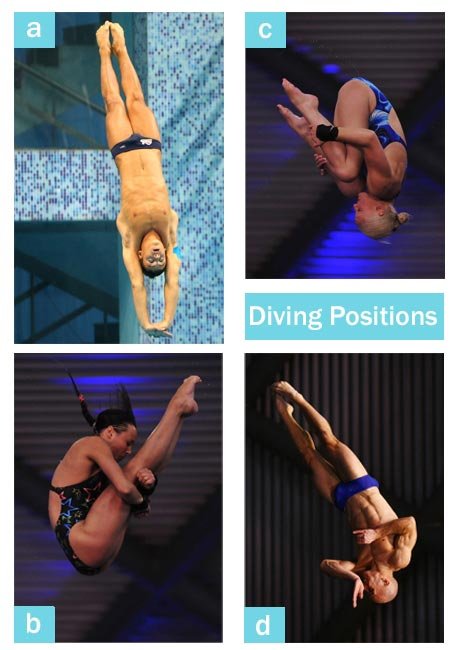Diving is one of the most exciting sports in the world. It involves leaping and springing into water, while trying to perfect a series of perfect body positions. But it is also very strictly controlled. If you want to learn more, or just discover some fascinating facts about the sport then read on….
If you’ve ever watch a diving competition you will have seen the strength, flexibility and courage of the divers. You may have also noticed that some divers perform different dives.
Despite this variety, the sport, and all the dives within it, are based on four distinct body positions:
- ‘Straight’ is where the body is kept in a fluid line, not being bent at the hips or knees.
- ‘Pike’ is where the body is bent at the hips but not the knees.
- ‘Tuck’ involves the body being bunched up tightly with the hands on the lower legs and
- ‘Free’ is only for twisting dives and can be a combination of at least two of the other positions. So a diver can bend their legs or bend their hips without being penalised
In a competition these positions are referred to by the letters A, B,C and D respectively, as can be seen in our illustration.

Dive groups
You may have also noticed that when they are standing on the diving platform or springboard divers will approach the dive from different positions.
All the positions can be placed into six different groups. These are as follows:
- Forward: The diver faces forward and rotates forward
- Backward: The diver faces backwards and rotates backwards
- Reverse: The diver faces forwards and rotates backwards
- Inward: The diver faces backwards and rotates forwards
- Twisting: These dives can be performed forwards, backwards, reverse or inwards, and involves a lateral twist.
- Armstand: These dives are performed only from platforms and begin from a handstand. They can be performed forwards or backwards, with forward, back or reverse rotation, and may include twists.
Did you know: A diver taking off from the 10m platform hits the water at 30mph and is in the air for less than three seconds.
Degree of Difficulty
Each dive has elements that make it more or less difficult than another dive. This includes the body position (or combinations of positions) and from what approach (group) the dive will be taken.
Each dive has its own ‘tariff’ or degree of difficulty – there is no distinction between running and standing take-offs.
Dives must be executed either head-first or feet-first into the water. In all cases the body must be straight with the feet together and the toes pointed. In head-first entries the arms need to be extended beyond the head, and in feet-first dives the arms must be at the sides. The entry into the water must be vertical or nearly so.
Platforms and springboards
All competitive diving is from springboards set at 1m and 3m above the surface of the water, or from firm boards (platforms) set at 5m, 7.5m and 10m. However, all major competitions (such as the Olympics) use the 10m platform only.
Scores
It is customary to have five or seven judges – seven at certain major international events – and they only focus on how the dive has been performed. The difficulty of a dive is taken care of by the tariff.
The highest and lowest marks are ignored. If there are five judges the remaining three scores are multiplied by the tariff to give the score for the dive. If there are seven judges, the five remaining scores are added together and then the result is mathematically adjusted to be the equivalent of three scores for comparison purposes.
In synchronised diving events, there is a panel of seven or nine judges; two to mark the execution of one diver, two to mark the execution of the other, and three or five to judge the synchronisation.
A few more diving facts:
- Britain’s Leon Taylor invented the back 2.5 somersaults, 2.5 twists. It is now used by many of the world’s top male divers.
- The fulcrum or ‘wheel’ on a springboard is adjusted to control the amount of spring the diver gets from the board.
- Rip – The word originates from the sound that is made when a diver enters the water without making a splash.
- During practice a bubble machine produces air bubbles in the water to decrease the surface tension of the water, cushioning impact for the diver when learning new skills.

